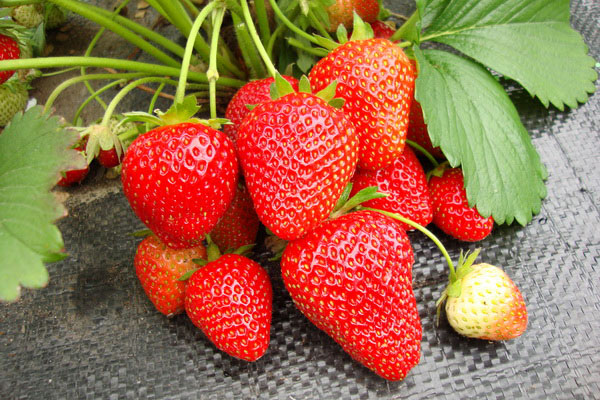Among the great variety of large-fruited garden strawberries there are those that can be called mega fruit. As a rule, these are plants of the remontant type of fruiting, although there are exceptions. Many of them have already become “hits” on Russian plantations. For example, Wima series, originator of which is the Dutch company "Vissers Aardbeiplanten". In this line are presented four varieties of strawberries: Rina, Xima, Tanda and Zanta.
Table of contents
About the Wim series - in general terms
The Vissers Company is an old and well-known breeding company specializing in the cultivation of strawberries since 1961. Visserss plantations are broken up in the southern part of the Netherlands, where the soils are sandy and light, a lot of light and other natural benefits that strawberries so much love.

The varieties of the Wim series, although combined into one line, are genetically different. Relatives are only Tarda and Zanta. Their main feature is the high mass of fruits. If usually fruits of garden strawberry fluctuate within 30 gthen in the Wim’s varieties, this indicator comes to 40-60 gand in some cases up to 100 g.
On the official website of the Vissers company, the varieties of the Wima series are distributed according to the fruiting time in this way:
| Wima zanta | Short day variety | The end of May - the end of June |
|---|---|---|
| Wima xima | Short day variety | The beginning of June - the beginning of July |
| Wima tarda | Short day variety | The beginning of June - the beginning of July |
| Wima rina | Neutral day variety | July - early November |
An explanation is required here. In Russia, it is customary to separate the concepts of “grade of a neutral day” (or “photoneutral”) and “remontant”. Remontrance in the domestic scientific understanding - the ability to re-fruiting.Such plants produce 2-4 waves of fruiting per season. Photo-neutral varieties - These are those who have a continuous bookmark of flower buds. Such strawberries will bear fruit throughout the season without interruption.
In Europe, the term “day neutral varieties” unites both remontrance and photon-neutrality. Therefore, when translating, confusion sometimes arises. It happened with the strawberry Wim Rin. In many descriptions it is called remontant. but According to reviews of gardeners, it is not observed waviness of fruiting. This is exactly the sort of neutral day.
Wima rina

The Rina variety was obtained by chance, by free pollination of the famous and very promising remontant strawberries Selva.
| Bush | Dense and leafy, semi-sprawling, with high-ribbed leaf plates of light green color. The ability to form a whisker is low. |
|---|---|
| Flowers | White, medium diameter, flower stalks - on the same level with the leaves. |
| Fruit | Large (45 g), cone-shaped with a pronounced neck, red, glossy. The taste is excellent, the rating at tasting is 4.8. The consistency of the pulp is dense, tender. The aroma is bright. |
| Yield | About 800 g with 1 bush. |
| Winter hardiness | High |
| Drought tolerance | Average |
| Transportability | Good |
| Grade assignment | Universal |
In this way, The advantages of the variety Wim Rin include high yields, large fruits, transportability and winter hardiness.
Wima zanta
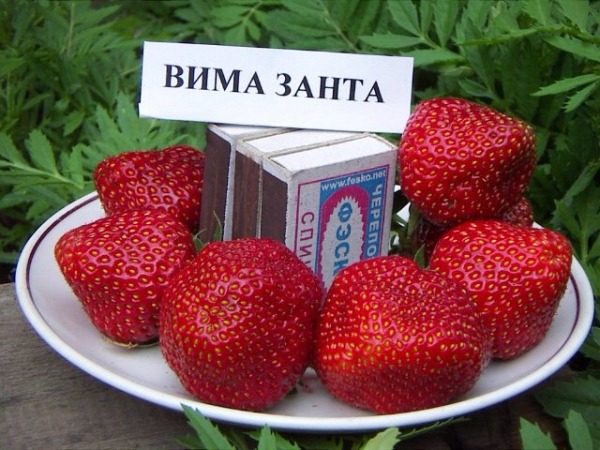
Zanta has a royal lineage. It is obtained by crossing super popular varieties Crown and Elsant.
| Bush | Strong, half sprawling. The sheet plates are characteristicly rolled inward. Throws a lot of mustache. |
|---|---|
| Flowers | White, medium size. Peduncle peduncles are located on the damage of the leaves, as the fruit is poured, they descend. |
| Fruit | Very high tasting ratings: juicy, medium dense, with hints of caramel and strawberry, with a strong aroma. Easily move away from the sepal, have a cavity inside. The shape of the fruit is mostly round, oblate, but can vary from collection to collection. Color is red, without gloss. |
| Yield | 600-800 g with 1 bush |
| Winter hardiness | Average |
| Drought tolerance | Good |
| Immunity | For verticillosis, Fusarium, gray rot. May be affected by powdery mildew. |
| Transportability | Average |
| Grade assignment | For fresh consumption, preservation, freezing. |
Summarizing the data the good qualities of the strawberry Wim Zanta can be called wonderful taste, high yield, ease of reproduction, drought resistance and immunity to major fungal infections.
Wima tarda
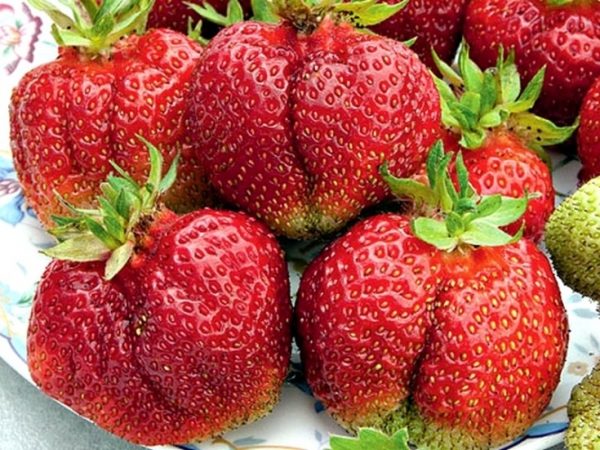
Tarda is the “daughter” of the strawberry Vima Zanta, which appeared from crossing with another hardy “Dutchman” - a variety of Vicoda.
| Bush | Strong, with a powerful sheet machine. Sheet plates are dark green, glossy. Mustache forms little. |
|---|---|
| Flowers | White, medium size, the arrangement of peduncles - at the level of the leaves and slightly lower. |
| Fruit | Very beautiful, large, without a cavity, dark red, shiny, with a rounded tip. Taste is pleasant, with gentle aroma. The flesh is dense, dark red. |
| Yield | 600 g with 1 bush |
| Winter hardiness | High |
| Drought tolerance | Average |
| Immunity | Tall |
| Transportability | Great |
| Purpose of the fruit | For processing, preservation, freezing |
In this way, main advantages of Wim Tarda - large-fruited, resistance to climatic conditions and diseases, excellent transportability.
Wima xima
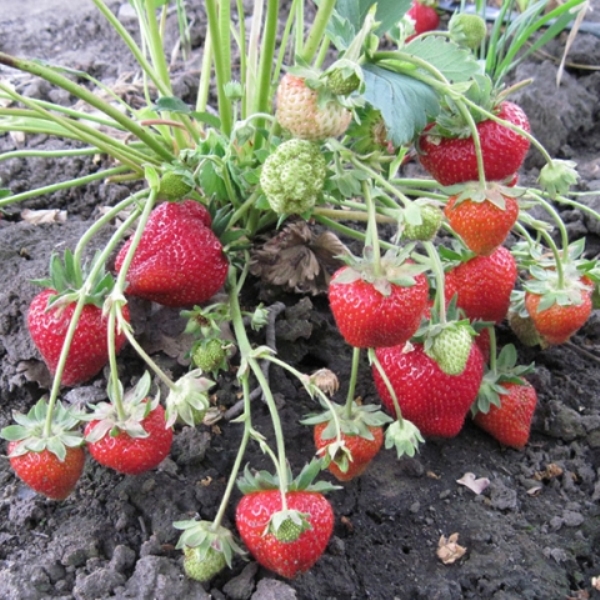
The most “purebred” strawberry from the series, which managed to surpass its three “namesakes”. Obtained by selecting random seedlings.
| Bush | Thick, powerful, with bright dark green leaf plates. The setting is low. |
|---|---|
| Flowers | White, peduncles rendered above the level of leaves, thick. |
| Fruit | Very large, weighing from 60 g and above. The shape is conical or comb, the color is dark red. The flesh is very juicy, sweet, tender, but it does not flow. The aroma is bright. |
| Yield | 700-800 g with 1 bush |
| Winter hardiness | Good |
| Drought tolerance | Good |
| Immunity | High to almost all fungal diseases. In rainy summer may be affected by gray mold. |
| Transportability | Average |
| Purpose of the fruit | Universal |
According to the responses of many gardeners, Xima variety is the best in the Wima lineup. The size of the berries, especially the first charges amaze, and the taste is beyond all praise. Good resistance of the variety makes it easy to adapt it for cultivation in most regions of Russia.
Care for long-fruiting varieties
The longer the strawberry bears fruit and the larger it forms the fruit, the more nutrition it needs. Rehabilitative and photon-neutral varieties do not have enough precipitation, soil resources, and their own strength to continuously produce record yields. therefore When growing such strawberries, watering and fertilizer come to the fore.
Intensive feeding required during the entire growing season, including flowering, setting and pouring fruit, ripening and leaving the plant to rest. It is necessary to make monthly full NPK complexes, as well as magnesium, calcium, boron, iron and manganese. Of course, such intensive use of mineral fertilizers has negative consequences. In pursuit of harvests, it is possible to “kill” the soil in the plot over several years.
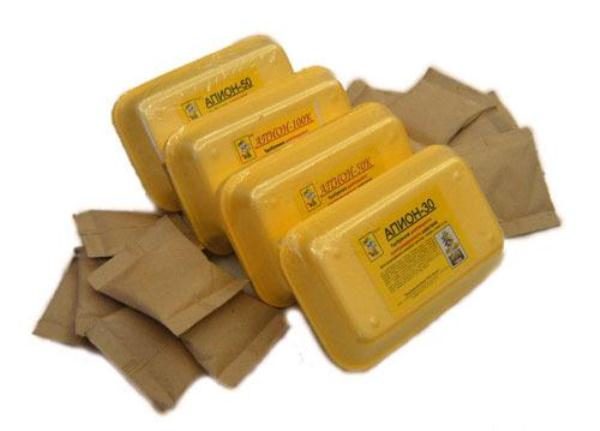
In such a situation, modern technologies are able to help out - long-acting fertilizers. For example, APION. This abbreviation stands for automatic feed osmotic pump. This is a complex feeding, which is contained inside the soft balls-dispensers. One ball is buried under a bush of strawberries, and fertilizers are released strictly metered throughout the season.
Wim's Strawberry Pests
The varieties of strawberries of the Wima series, as well as any others, can be attacked by pests.
Strawberry Mite
Females of this insect lay on young, not yet unfolded leaves. Mite colonies suck out cell sap, leaves curl, fruits do not grow well and shrink.
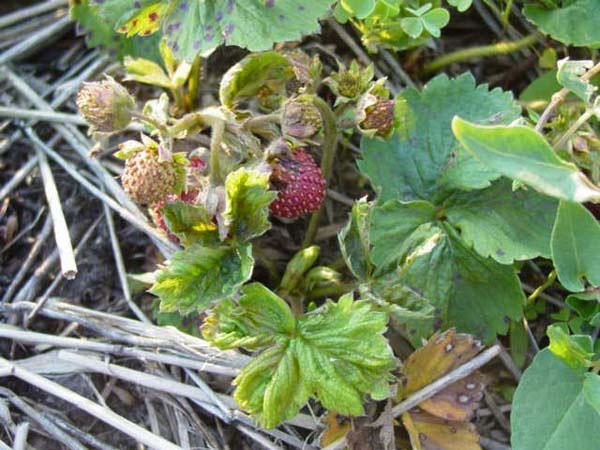
To combat strawberry mite in early spring, when the leaves begin to unfold, they are treated with Karbofos, and before flowering with the preparation Neoron.
Strawberry Nematode
It is a roundworm settling in the root system of a plant. The affected plant is strongly inhibited, weakens, deforms and soon dies.. Nematodes multiply very quickly, therefore, having noticed a sick bush at the site, it is necessary to immediately dig and burn it.
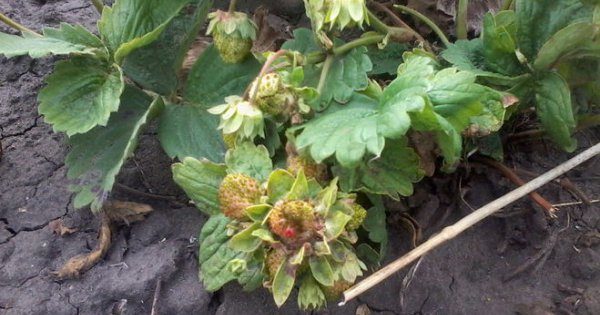
There is no specific treatment for nematode, but for prevention can be planted around the perimeter of strawberry beds marigolds.
Weevils (elephants)
The insect females lay eggs in strawberry buds, and the hatched larvae eat them away from the inside. Therefore, if weevil has attacked the plantation, you can lose the harvest already at the flowering stage.
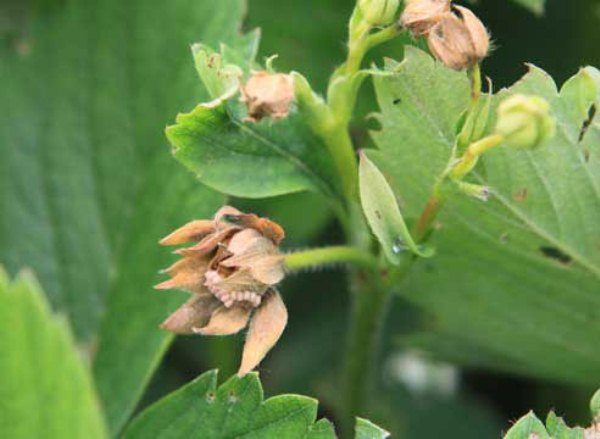
Well helps from elephants solution Fitoverm, which need to process the plants in the phase of buds and in time of flowering. According to the observations of gardeners, wonderful scare weevils feverfew - garden daisies planted on strawberries.
Aphid
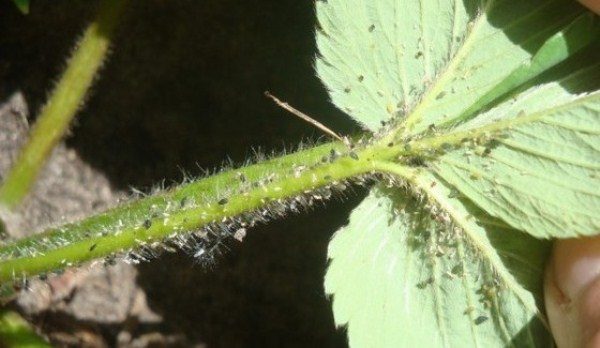
Another sucking pest and carrier of viral infections. Aphids can be defeated by the same Fitoverm or folk remedies.. For example, ash-soap solution. A piece of household soap, or better tar soap, should be grated, mixed with a glass of wood ash and dissolved in 3 liters of water.The resulting composition is well washed all strawberry bushes.
Reviews of varieties of strawberry Vima
Anna: I know Rina and Tanda well, they have been growing on my site for 5 years already. In the heat of last summer, Tanda stoked, but Rina stood and fruited until mid-October. Filmed green berries ripened in 2 days.
Victoria: from large-fruited strawberries planted in one year Gigantella, Chamoru Tarusi and Vima Xima. Only the latter did not disappoint. Among all the giants - the latest, but the most delicious.
Sergei: Rina, Zantoux and Tardu planted on a plantation in the Republic of Mari El. In our region had to abandon them. They matured poorly, did not gain sugar content, and were poorly pollinated. It is possible that in other regions they better reveal their potential.
Valentina: Vima Zanta is a very tasty variety! In the first two years after planting, the berry was very large, but then crushed, yields decreased. Sorry, but had to be removed.
Nikolay: Zanta - just a godsend for a home plot. Taste and fresh, and in processing excellent! Resistant to gray mold and root diseases. But for industrial cultivation is not very suitable, removed without sepals, poorly transported.
Michael: Wima Xima is a super variety! Bushes are powerful, the berries are beautiful, tasty, not crunchy, sweet. Individual copies were shot and joked: not strawberries, but strawberry apples! Mass reached 100-120 grams. This giant.
Conclusion
Large-fruited varieties of garden strawberries of the Wim series are not suitable for summer residents who visit the site with rare “forays”. They require a lot of attention and care.. Sometimes "naughty", poorly adapting to local conditions. But if you manage to make friends with them, the Wima varieties compensate for all your efforts with a rich harvest of excellent berries.
